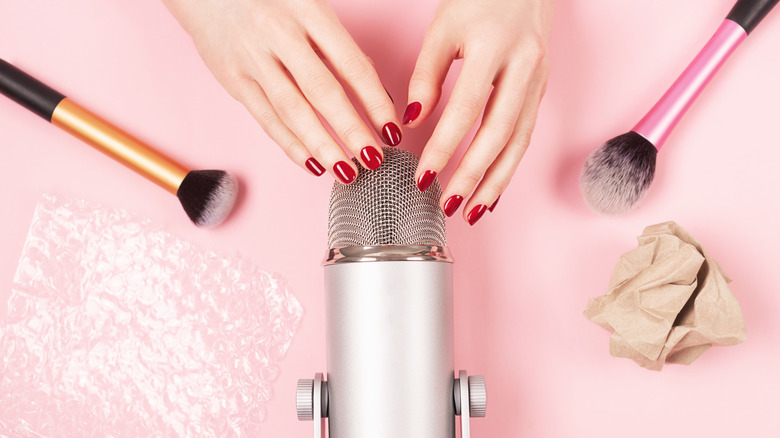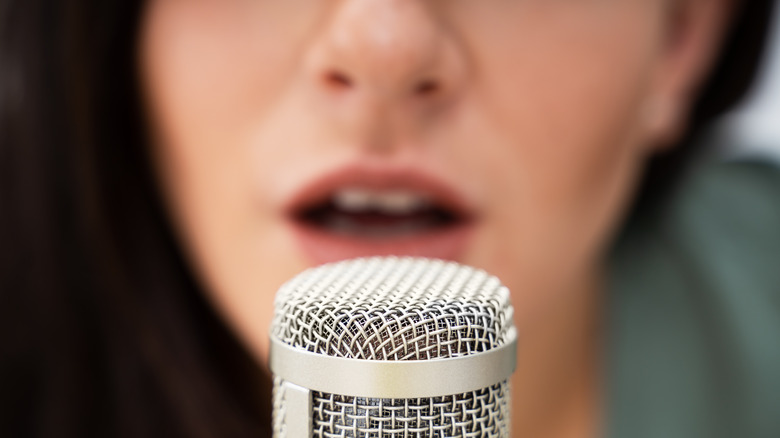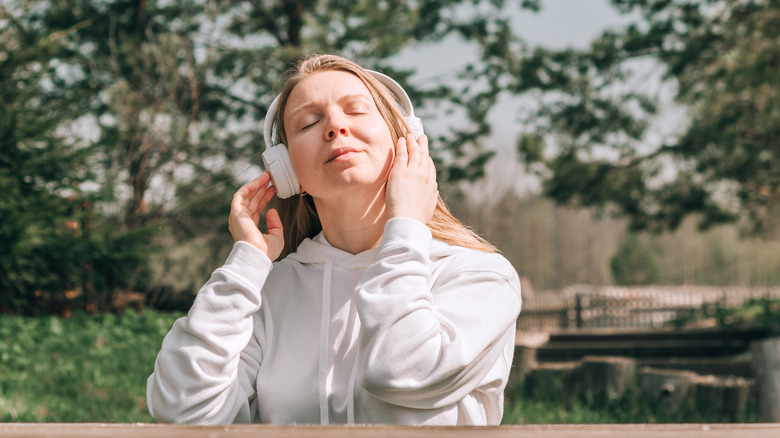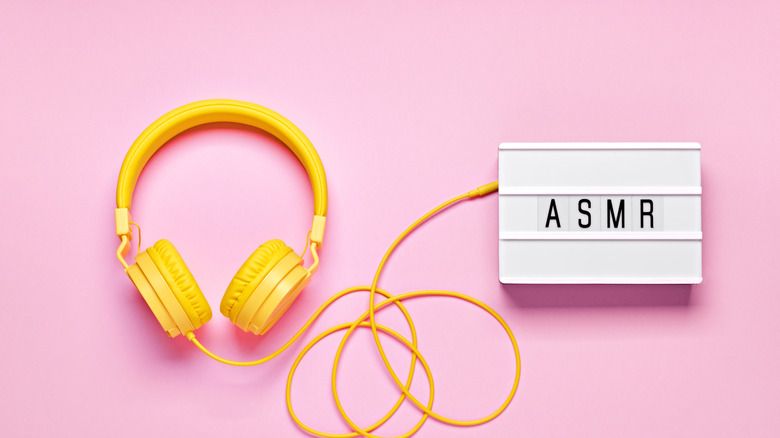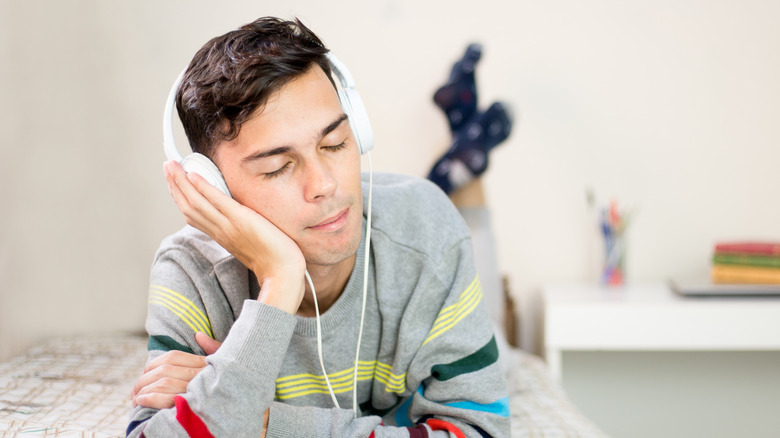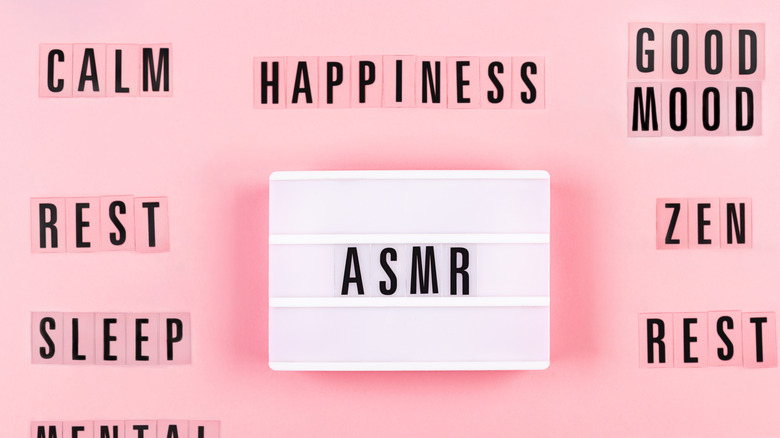The Scientific Reason Why Only Some People Respond To ASMR
According to Verywell Mind, ASMR stands for autonomous sensory meridian response. In brief, it's a sensation derived from specific stimuli referred to as "triggers" (via The Conversation). Now considered to be one of the most in-demand searches on YouTube, The New York Times writes that the term was coined by Jennifer Allen in 2010. For years, she struggled to explain the warm tingling feeling she got when she watched certain videos. However, in 2009 Allen found an online forum with people who said that they too felt the same sensations from a variety of triggers like hair brushing and whispering sounds.
She later created the term "ASMR" to prevent it from being sexualized and to legitimize this anomaly. Since then, CNN reports that ASMR has exploded on YouTube and other social media platforms. Some ASMR creators have millions of subscribers while videos can garner over 38 million views. Simply put, ASMR is here to stay as creators post hundreds of new videos daily. Smithsonian Magazine explains that these can be anything from a mundane activity to tapping on various objects and role-playing common scenarios, like doctor's appointments. Per Verywell Mind, not everyone can experience ASMR, but those that do can offer insight into this rarely researched phenomenon.
Common ASMR triggers
ASMR is all about triggers and finding what works for the viewer or listener (via Verywell Mind). ASMR University writes that triggers can elicit both physical and psychological sensations. For example, sometimes one can feel tingles throughout their body. Other times, it can cause an overall feeling of well-being and comfort. In addition, the tingles from ASMR specifically develop at the top of the head and occur without physical touch. Goosebumps are also frequent. Common triggers include soft voices, personal attention, hand movements, clear-cut sounds, and much more (per The Conversation). Furthermore, it's believed that ASMR first appears in childhood (some triggers include lice checking).
Giulia Poerio from the University of Sheffield likens it to a synesthetic experience. Smithsonian Magazine reports that videos that involve role-playing as librarians, flight attendants, or makeup artists are perhaps extremely popular for this very reason. ASMR University elaborates that role-playing videos combine different triggers and the gentle disposition of the ASMR artist to create a soothing experience that involves the viewer or participant.
The positive effects of ASMR
The Conversation writes that the tingles caused by ASMR can ultimately lead to feelings of elation and tranquility. It's no wonder that the phenomenon has continued to skyrocket, per CNN. In fact, it's believed that 20% of people can experience ASMR. According to ASMR University, viewers have reported a wide range of benefits from experiencing triggers from ASMR videos. They include a decrease in stress, sadness, and an overall feeling of contentment. Some have compared it to the same feeling as those who practice mindfulness. Additionally, it's believed to decrease insomnia (via Smithsonian Magazine). As explained by Vox, it's important to discern that ASMR and triggers are not in shape or form sexual.
Craig Richard, founder of ASMR University, told CNN that, "It's very similar to the feeling of sitting down on a couch with a loved one you feel safe with, and when you feel safe with someone, you relax." Interestingly, The Guardian writes that over time, users can develop "ASMR immunity." In other words, the tingles can decrease if someone listens to a particular video or sound continually. Many believe that this is why ASMR artists that have unusual accents tend to be more popular and why various types of ASMR videos keep emerging; a creator has to keep it fresh to bring in views and subscribers.
Little scientific research has been done on ASMR
According to Vox, ASMR has not been widely studied or researched. Despite this, Richard from ASMR university notes that, "ASMR is a global experience" (via CNN). Using MRIs, it's been found that ASMR lights up the reward center in the brain. This might explain why a majority of people describe feeling so good after experiencing tingles and why people keep coming back to ASMR. In addition, a 2017 study from the University of Winnipeg concluded that those who experienced ASMR scored higher for a personality trait referred to as "openness of experience." This meant they were more curious, artistic, and more sensitive to stimuli from all senses.
Per The Conversation, ASMR can also light up regions of the brain associated with emotion and empathy. Smithsonian Magazine writes that some researchers believe ASMR is connected to synesthesia, a phenomenon in which people describe being able to taste shapes and see numbers in color. Just like ASMR, not everyone can experience this.
Northrop Grumman reports that this is possibly due to misophonia, the hatred of certain sounds (like chewing). Oddly, The Conversation reports that those with misophonia are more likely to experience ASMR. However, this doesn't mean they take pleasure in it; it means it can trigger a negative response that is the complete opposite of those who revel in ASMR.
ASMR is not a pseudoscience
As explained by Scientific American , many believe that ASMR is not real and is a result of drugs or even loneliness. This is because not everyone can experience ASMR. However, The Guardian writes that although the word "ASMR” is itself pseudoscience because it was invented, the phenomenon is not. Of course, It's human nature to chalk up something that not everyone can experience as non-existent.
Poerio notes that, "We think the same thing that drives the ability to experience ASMR — a heightened sensory sensitivity — can in other contexts create a negative reaction." This leads back to the theory that people who are more likely to experience ASMR are those who experience misophonia, something that only about 20% of the population has (via CNN).
Northrop Grumman notes that because ASMR is not experienced by everyone, it is likely to remain a niche and even a taboo subject. Despite this, Vox reports that ASMR creators are seeking to create new experiences for their viewers. Maria, an ASMR creator, known as "Gentle Whispering ASMR" on YouTube stated that, "We're trying to give people as much entertainment as we can, and give them options to choose from." This is undoubtedly a positive contribution as ASMR has been found to be therapeutic for many, per Verywell Mind.
ASMR could potentially help treat anxiety
A 2018 study done by Poerio found that those who experience ASMR had reduced heartbeats and increased skin conductance. Per The Conversation, the stress relief produced by ASMR was similar to those who use music therapy. The big question here then, is how effective can ASMR be to treat depression, anxiety, and insomnia (via Verywell Mind)? CNN explains that there has not been enough research for this aforementioned topic. However, many believe that ASMR should be viewed as a tool along with therapy and other activities. Richard stated that "It's another aspect of self-care that's helping people deal with their stress."
Another study found that those who experience ASMR are more likely to suffer from high anxiety and other mental health issues (per Healthline). A different article from The Conversation reports that even those who don't experience ASMR can benefit from the calming effects of ASMR videos if they suffer from anxiety. Although it's unknown if ASMR can truly induce sleep, a survey found that 81% watched ASMR before bed because it helped them fall asleep. According to Verywell Mind, ASMR and how it affects individuals physiologically is still being deciphered. Nonetheless, Smithsonian Magazine writes that it could eventually better explain how the brain processes different senses.
